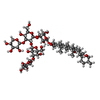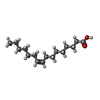+ Open data
Open data
- Basic information
Basic information
| Entry |  | |||||||||
|---|---|---|---|---|---|---|---|---|---|---|
| Title | Human PORCN in complex with palmitoleoylated WNT3A peptide | |||||||||
 Map data Map data | membrane protein | |||||||||
 Sample Sample |
| |||||||||
| Function / homology |  Function and homology information Function and homology information[Wnt protein] O-palmitoleoyl transferase / Wnt signaling pathway involved in forebrain neuroblast division / positive regulation of dermatome development / axis elongation involved in somitogenesis / calcium ion transmembrane transport via low voltage-gated calcium channel / : / LGK974 inhibits PORCN / protein palmitoleylation / positive regulation of collateral sprouting in absence of injury / palmitoleoyltransferase activity ...[Wnt protein] O-palmitoleoyl transferase / Wnt signaling pathway involved in forebrain neuroblast division / positive regulation of dermatome development / axis elongation involved in somitogenesis / calcium ion transmembrane transport via low voltage-gated calcium channel / : / LGK974 inhibits PORCN / protein palmitoleylation / positive regulation of collateral sprouting in absence of injury / palmitoleoyltransferase activity / positive regulation of mesodermal cell fate specification / paraxial mesodermal cell fate commitment /  cell proliferation in midbrain / spinal cord association neuron differentiation / Formation of the posterior neural plate / Wnt protein secretion / lipid modification / cell proliferation in midbrain / spinal cord association neuron differentiation / Formation of the posterior neural plate / Wnt protein secretion / lipid modification /  COP9 signalosome assembly / COP9 signalosome assembly /  protein lipidation / Wnt-Frizzled-LRP5/6 complex / positive regulation of cell-cell adhesion mediated by cadherin / glycoprotein metabolic process / Negative regulation of TCF-dependent signaling by WNT ligand antagonists / protein lipidation / Wnt-Frizzled-LRP5/6 complex / positive regulation of cell-cell adhesion mediated by cadherin / glycoprotein metabolic process / Negative regulation of TCF-dependent signaling by WNT ligand antagonists /  synaptic vesicle recycling / Signaling by RNF43 mutants / positive regulation of cardiac muscle cell differentiation / WNT ligand biogenesis and trafficking / synaptic vesicle recycling / Signaling by RNF43 mutants / positive regulation of cardiac muscle cell differentiation / WNT ligand biogenesis and trafficking /  cell proliferation in forebrain / cell proliferation in forebrain /  secondary palate development / negative regulation of axon extension involved in axon guidance / somatic stem cell division / non-canonical Wnt signaling pathway / secondary palate development / negative regulation of axon extension involved in axon guidance / somatic stem cell division / non-canonical Wnt signaling pathway /  co-receptor binding / cardiac muscle cell fate commitment / presynapse assembly / positive regulation of skeletal muscle tissue development / Wnt-protein binding / dorsal/ventral neural tube patterning / negative regulation of dopaminergic neuron differentiation / midbrain dopaminergic neuron differentiation / regulation of postsynapse to nucleus signaling pathway / post-anal tail morphogenesis / co-receptor binding / cardiac muscle cell fate commitment / presynapse assembly / positive regulation of skeletal muscle tissue development / Wnt-protein binding / dorsal/ventral neural tube patterning / negative regulation of dopaminergic neuron differentiation / midbrain dopaminergic neuron differentiation / regulation of postsynapse to nucleus signaling pathway / post-anal tail morphogenesis /  mammary gland development / positive regulation of neural precursor cell proliferation / mammary gland development / positive regulation of neural precursor cell proliferation /  frizzled binding / positive regulation of hepatocyte proliferation / Class B/2 (Secretin family receptors) / myoblast differentiation / Disassembly of the destruction complex and recruitment of AXIN to the membrane / inner ear morphogenesis / negative regulation of fat cell differentiation / regulation of synapse organization / heart looping / fat cell differentiation / B cell proliferation / Formation of paraxial mesoderm / skeletal muscle cell differentiation / regulation of postsynaptic membrane neurotransmitter receptor levels / AMPA glutamate receptor complex / positive regulation of receptor internalization / frizzled binding / positive regulation of hepatocyte proliferation / Class B/2 (Secretin family receptors) / myoblast differentiation / Disassembly of the destruction complex and recruitment of AXIN to the membrane / inner ear morphogenesis / negative regulation of fat cell differentiation / regulation of synapse organization / heart looping / fat cell differentiation / B cell proliferation / Formation of paraxial mesoderm / skeletal muscle cell differentiation / regulation of postsynaptic membrane neurotransmitter receptor levels / AMPA glutamate receptor complex / positive regulation of receptor internalization /  hemopoiesis / regulation of presynapse assembly / canonical Wnt signaling pathway / hemopoiesis / regulation of presynapse assembly / canonical Wnt signaling pathway /  cell fate commitment / regulation of microtubule cytoskeleton organization / positive regulation of B cell proliferation / cellular response to retinoic acid / Regulation of FZD by ubiquitination / extracellular matrix organization / TCF dependent signaling in response to WNT / cell fate commitment / regulation of microtubule cytoskeleton organization / positive regulation of B cell proliferation / cellular response to retinoic acid / Regulation of FZD by ubiquitination / extracellular matrix organization / TCF dependent signaling in response to WNT /  cytokine activity / cytokine activity /  axon guidance / positive regulation of cytokine production / hippocampus development / positive regulation of protein localization to plasma membrane / modulation of chemical synaptic transmission / axon guidance / positive regulation of cytokine production / hippocampus development / positive regulation of protein localization to plasma membrane / modulation of chemical synaptic transmission /  protein localization / neuron differentiation / protein localization / neuron differentiation /  platelet aggregation / osteoblast differentiation / platelet aggregation / osteoblast differentiation /  Wnt signaling pathway / negative regulation of neurogenesis / Golgi lumen / positive regulation of canonical Wnt signaling pathway / endocytic vesicle membrane / negative regulation of neuron projection development / presynapse / positive regulation of peptidyl-serine phosphorylation / Wnt signaling pathway / negative regulation of neurogenesis / Golgi lumen / positive regulation of canonical Wnt signaling pathway / endocytic vesicle membrane / negative regulation of neuron projection development / presynapse / positive regulation of peptidyl-serine phosphorylation /  heart development / early endosome membrane / cell population proliferation / in utero embryonic development / transcription by RNA polymerase II / heart development / early endosome membrane / cell population proliferation / in utero embryonic development / transcription by RNA polymerase II /  transcription coactivator activity / transcription coactivator activity /  receptor ligand activity / positive regulation of protein phosphorylation / protein domain specific binding / receptor ligand activity / positive regulation of protein phosphorylation / protein domain specific binding /  endoplasmic reticulum lumen / endoplasmic reticulum lumen /  signaling receptor binding / glutamatergic synapse signaling receptor binding / glutamatergic synapseSimilarity search - Function | |||||||||
| Biological species |   Homo sapiens (human) / Homo sapiens (human) /   Mus musculus (house mouse) Mus musculus (house mouse) | |||||||||
| Method |  single particle reconstruction / single particle reconstruction /  cryo EM / Resolution: 3.19 Å cryo EM / Resolution: 3.19 Å | |||||||||
 Authors Authors | Liu Y / Qi X / Li X | |||||||||
| Funding support |  United States, 2 items United States, 2 items
| |||||||||
 Citation Citation |  Journal: Nature / Year: 2022 Journal: Nature / Year: 2022Title: Mechanisms and inhibition of Porcupine-mediated Wnt acylation. Authors: Yang Liu / Xiaofeng Qi / Linda Donnelly / Nadia Elghobashi-Meinhardt / Tao Long / Rich W Zhou / Yingyuan Sun / Boyuan Wang / Xiaochun Li /   Abstract: Wnt signalling is essential for regulation of embryonic development and adult tissue homeostasis, and aberrant Wnt signalling is frequently associated with cancers. Wnt signalling requires ...Wnt signalling is essential for regulation of embryonic development and adult tissue homeostasis, and aberrant Wnt signalling is frequently associated with cancers. Wnt signalling requires palmitoleoylation on a hairpin 2 motif by the endoplasmic reticulum-resident membrane-bound O-acyltransferase Porcupine (PORCN). This modification is indispensable for Wnt binding to its receptor Frizzled, which triggers signalling. Here we report four cryo-electron microscopy structures of human PORCN: the complex with the palmitoleoyl-coenzyme A (palmitoleoyl-CoA) substrate; the complex with the PORCN inhibitor LGK974, an anti-cancer drug currently in clinical trials; the complex with LGK974 and WNT3A hairpin 2 (WNT3Ap); and the complex with a synthetic palmitoleoylated WNT3Ap analogue. The structures reveal that hairpin 2 of WNT3A, which is well conserved in all Wnt ligands, inserts into PORCN from the lumenal side, and the palmitoleoyl-CoA accesses the enzyme from the cytosolic side. The catalytic histidine triggers the transfer of the unsaturated palmitoleoyl group to the target serine on the Wnt hairpin 2, facilitated by the proximity of the two substrates. The inhibitor-bound structure shows that LGK974 occupies the palmitoleoyl-CoA binding site to prevent the reaction. Thus, this work provides a mechanism for Wnt acylation and advances the development of PORCN inhibitors for cancer treatment. | |||||||||
| History |
|
- Structure visualization
Structure visualization
| Supplemental images |
|---|
- Downloads & links
Downloads & links
-EMDB archive
| Map data |  emd_26710.map.gz emd_26710.map.gz | 43.1 MB |  EMDB map data format EMDB map data format | |
|---|---|---|---|---|
| Header (meta data) |  emd-26710-v30.xml emd-26710-v30.xml emd-26710.xml emd-26710.xml | 19.9 KB 19.9 KB | Display Display |  EMDB header EMDB header |
| Images |  emd_26710.png emd_26710.png | 49.3 KB | ||
| Others |  emd_26710_half_map_1.map.gz emd_26710_half_map_1.map.gz emd_26710_half_map_2.map.gz emd_26710_half_map_2.map.gz | 77.6 MB 77.6 MB | ||
| Archive directory |  http://ftp.pdbj.org/pub/emdb/structures/EMD-26710 http://ftp.pdbj.org/pub/emdb/structures/EMD-26710 ftp://ftp.pdbj.org/pub/emdb/structures/EMD-26710 ftp://ftp.pdbj.org/pub/emdb/structures/EMD-26710 | HTTPS FTP |
-Related structure data
| Related structure data |  7ureMC 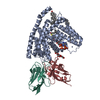 7uraC  7urcC 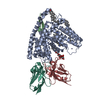 7urdC 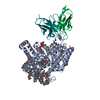 7urfC M: atomic model generated by this map C: citing same article ( |
|---|---|
| Similar structure data | Similarity search - Function & homology  F&H Search F&H Search |
- Links
Links
| EMDB pages |  EMDB (EBI/PDBe) / EMDB (EBI/PDBe) /  EMDataResource EMDataResource |
|---|---|
| Related items in Molecule of the Month |
- Map
Map
| File |  Download / File: emd_26710.map.gz / Format: CCP4 / Size: 83.7 MB / Type: IMAGE STORED AS FLOATING POINT NUMBER (4 BYTES) Download / File: emd_26710.map.gz / Format: CCP4 / Size: 83.7 MB / Type: IMAGE STORED AS FLOATING POINT NUMBER (4 BYTES) | ||||||||||||||||||||
|---|---|---|---|---|---|---|---|---|---|---|---|---|---|---|---|---|---|---|---|---|---|
| Annotation | membrane protein | ||||||||||||||||||||
| Voxel size | X=Y=Z: 0.83 Å | ||||||||||||||||||||
| Density |
| ||||||||||||||||||||
| Symmetry | Space group: 1 | ||||||||||||||||||||
| Details | EMDB XML:
|
-Supplemental data
-Half map: membrane protein
| File | emd_26710_half_map_1.map | ||||||||||||
|---|---|---|---|---|---|---|---|---|---|---|---|---|---|
| Annotation | membrane protein | ||||||||||||
| Projections & Slices |
| ||||||||||||
| Density Histograms |
-Half map: membrane protein
| File | emd_26710_half_map_2.map | ||||||||||||
|---|---|---|---|---|---|---|---|---|---|---|---|---|---|
| Annotation | membrane protein | ||||||||||||
| Projections & Slices |
| ||||||||||||
| Density Histograms |
- Sample components
Sample components
+Entire : product-bound human PORCN
+Supramolecule #1: product-bound human PORCN
+Supramolecule #2: Isoform 2 of Protein-serine O-palmitoleoyltransferase porcupine (...
+Supramolecule #3: 2C11 light chain, 2C11 heavy chain
+Supramolecule #4: Isoform 2 of Protein Wnt-3a
+Macromolecule #1: Isoform 2 of Protein-serine O-palmitoleoyltransferase porcupine
+Macromolecule #2: 2C11 light chain
+Macromolecule #3: 2C11 heavy chain
+Macromolecule #4: Isoform 2 of Protein Wnt-3a
+Macromolecule #5: Digitonin
+Macromolecule #6: ZINC ION
+Macromolecule #7: PALMITOLEIC ACID
-Experimental details
-Structure determination
| Method |  cryo EM cryo EM |
|---|---|
 Processing Processing |  single particle reconstruction single particle reconstruction |
| Aggregation state | particle |
- Sample preparation
Sample preparation
| Buffer | pH: 7.5 |
|---|---|
| Vitrification | Cryogen name: ETHANE |
- Electron microscopy
Electron microscopy
| Microscope | FEI TITAN KRIOS |
|---|---|
| Electron beam | Acceleration voltage: 300 kV / Electron source:  FIELD EMISSION GUN FIELD EMISSION GUN |
| Electron optics | Illumination mode: FLOOD BEAM / Imaging mode: BRIGHT FIELD Bright-field microscopy / Nominal defocus max: 2.0 µm / Nominal defocus min: 0.7000000000000001 µm Bright-field microscopy / Nominal defocus max: 2.0 µm / Nominal defocus min: 0.7000000000000001 µm |
| Image recording | Film or detector model: GATAN K3 (6k x 4k) / Average electron dose: 8.5 e/Å2 |
| Experimental equipment |  Model: Titan Krios / Image courtesy: FEI Company |
- Image processing
Image processing
| Initial angle assignment | Type: NOT APPLICABLE |
|---|---|
| Final angle assignment | Type: NOT APPLICABLE |
| Final reconstruction | Resolution.type: BY AUTHOR / Resolution: 3.19 Å / Resolution method: FSC 0.143 CUT-OFF / Number images used: 113566 |
 Movie
Movie Controller
Controller










 Z
Z Y
Y X
X

















